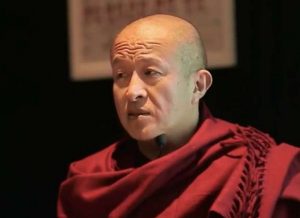
The final factor of the Noble Eightfold Path is Right Concentration. In The Road to Inner Freedom, Venerable Mahathera Nyanaponika writes:
Right Concentration . . . ensures one pointedness of mind. It is the ability to focus steadily one’s mind on any one object and one only, to the exclusion of all others. There are many exercises in mind concentration. Long-continued practice of mental concentration makes the mind highly penetrative. It becomes like a high powered light which can thoroughly illuminate any object on which it is focused. Hence any object of thought which presents itself to such a mind is thoroughly penetrated and comprehended. . . . Now this concentration of the mind, like virtue, is not an end in itself. The purpose of developing this Samadhi or Concentration is to make use of its penetrative power to understand existence and thereby realize the Highest Wisdom.
We now come to . . . Panna or Wisdom. When this highly concentrated mind, abiding in Samadhi, is made to focus its attention on the three great characteristics of existence, namely Impermanence, Suffering, and Egolessness . . . the mind is able to see things as they actually are. The result is the dawning of the Highest Understanding, which is the first factor of the Eightfold Path, and, when perfected, its culmination, one sees Reality. This realization coincides with the cessation of Craving and the attainment of Nibbana.
(Nyanaponika 1982, 72)
This sums it up well, but we can break it down and discuss Right Concentration in more detail.
The Buddha said: “What now is Right Concentration? Having the mind fixed to a single object (one pointedness of mind): this is concentration.” (Majjhima Nikaya 44).
Right Concentration depends on one-pointedness, but there are different levels of one-pointedness. Just being able to concentrate on one mind-object to the exclusion of all else is not enough. It may help to sort out the tangle, but one-pointedness is not just an end in itself. It must be directed to higher purposes and to Right Understanding, so the meditator should avoid concentration on bodily or unwholesome mind states. Someone practicing tantra sensuality may have one-pointedness or a warrior about to kill with his sword may have one-pointedness, but they would obviously be missing the point in Buddhist meditation. One has to transcend the level of worldly states and concentrate on an object in a manner that causes wholesome states to arise.
Right Concentration reflects the achievements of all of the factors of the Noble Eightfold Path, playing a role simultaneously in helping to maintain the right kind of one-pointedness, but it also looks forward to the attainment of new mental states.
It looks back to and draws upon:
Right Understanding
Right Effort
Right Intentions
Right Mindfulness
It reflects the Four Foundations of Mindfulness:
Contemplation of body
Contemplation of feeling
Contemplation of the mind
Contemplation of mind-objects
It requires the Four Great Efforts:
I. Abandon unwholesome mental states before they arise by blocking the five hindrances:
• Sensual desire
• Ill-will
• Dullness/drowsiness
• Restless worry
• Doubt
II. Abandon arisen unwholesome states through concentration upon:
• The impermanence of life
• Deterioration of the body
• Loving-kindness
• Compassion
• Breath meditation
• Investigative analysis
• And other meditation forms suggested by the Buddha
III. Arouse wholesome unarisen states through the Seven Steps to Enlightenment:
• Mindfulness
• Investigation
• Energy
• Rapture
• Tranquility
• Concentration
• Equanimity
IV. Maintain arisen wholesome states through illuminating the Four Noble Truths:
• The nature of suffering
• The cause of suffering
• The extinction of suffering
• The Middle Way
This is where Right Concentration looks forward to a realization through Right Mindfulness of:
The impermanence of the moment
The fleeting nature of existence
The transitory nature of being
The vanity of grasping
The illusory nature of consciousness
Freedom from the delusion of self
Deliverance from worldly desire
Detached concentration
Rapture
Tranquillity
Equanimity
Accompanying detached observation, watching the play of events, after extended practice, the meditator comes to learn about two methods of concentration.
In the first method, insight meditation, the meditator “does not deliberately attempt to exclude the multiplicity of phenomena from his field of attention. Instead, he simply directs mindfulness to the changing states of mind and body, noting any phenomenon that presents itself; his task is to maintain a continuous awareness of whatever enters the range of perception, clinging to nothing. As he goes on with his noting, concentration becomes stronger moment after moment, until it becomes established one-pointedly, on the constantly changing stream of events.” (Bodhi 117)
When this technique is practiced sufficiently, it leads to a breakthrough to the final stage of the path: insight and wisdom.
The second method is called tranquility meditation. In this discipline, the meditator concentrates firmly upon one object, presumably the meditation object given by a teacher. While doing breathing meditation, “he focuses his mind on the object and tries to keep it there, fixed and alert. If the mind strays, he notices this quickly, catches it and brings it back gently but firmly to the object, doing this over and over as often as it is necessary.” (Bodhi 109)
This is called initial application. Sustained application anchors the attention on the object and holds it there until the meditator begins to experience rapture (delight or joy), which accompanies having achieved pure concentration, and happiness (pleasure), which accompanies the restful and refreshing nature of continued concentration. The process culminates in one-pointedness.
As one continues to meditate, these factors combine, complement one another, and pick up power to steer the mind to mental states called absorptions, which are “beyond the reach of the five-fold sense activity, attainable only in solitude and by unremitting perseverance. In these states, all activity of the five senses is suspended. No visual or audible impressions arise at such a time, no bodily feeling is felt. But although all other sense impressions have ceased, the mind remains active, perfectly alert, fully awake.” (Nyanatiloka 1982, 79)
References
Bodhi, Bhikkhu. 1984. The Noble Eightfold Path: The Way to End Suffering. Kandy: Buddhist Publication Society.
Nyanaponika, Mahathera. 1982. The Road to Inner Freedom. Kandy: Buddhist Publication Society.
Nyanatiloka, Mahathera. 1967. The Word of the Buddha. Kandy: Buddhist Publication Society.
Related features from Buddhistdoor Global
Do I Need a Teacher to Practice Meditation?
Some Observations on the Subject of Meditation
It All Matters: On Metta, Feelings, and Forgiveness














